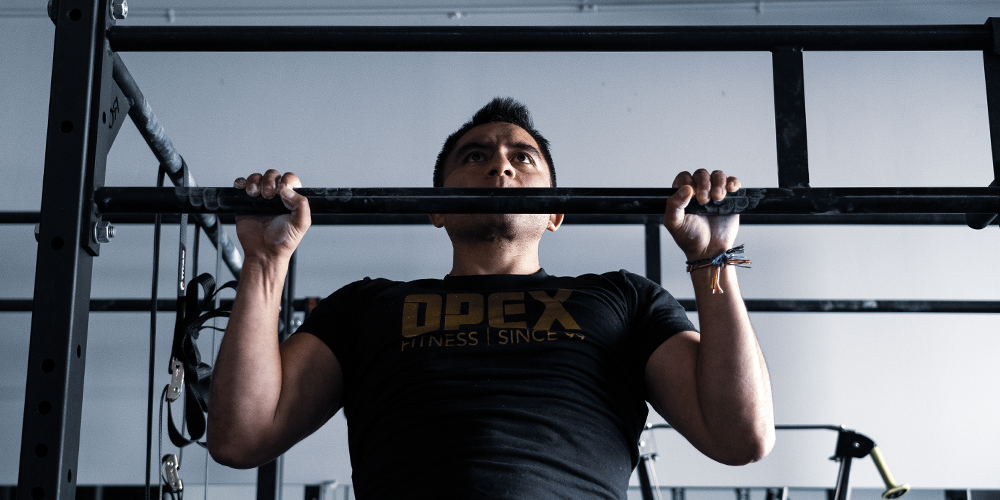SEVEN DIFFERENT PULL-UP GRIPS AND THEIR BENEFITS
When we think of pull-ups, we often default to two options: the chin-up grip or the pull-up grip—i.e. a pronated or supinated.
But there are tons of other pull-up grip options, all of which can be useful, depending on the individual’s intentions, strengths and weaknesses, and goals.
Let's take a look at seven of them.
Pronated (pull-up)
The traditional pronated pull-up grip is a great way to build lat and rhomboid strength and to a lesser degree the forearms, shoulders, and biceps. This means, that for someone who tends to want to use their biceps over their lats during a pull-up, taking a pronated grip is useful for ensuring the lats are being targeted over the biceps.
Tip: When starting the pull, focus first on depressing the scapula and engaging the lats and then driving the elbows straight down, all the while keeping the shoulders pulled down. Without keeping the shoulder blades depressed, the movement will become too reliant on the upper traps.
Sample accessory work for pull-ups:
A1. Horizontal Single Arm Band Row @2112, 15 reps x 3 sets; 60 seconds rest
A2. Scapular Pull-Ups @1010, 8-10 reps x 3 sets; 60 seconds rest
Supinated (chin-up)
The traditional supinated chin-up grip will still help build lat strength, however, it also targets your biceps and even your chest, so can be a great tool for those with strong lats looking to strengthen their biceps.
As a result of their bicep bias, chin-ups, and specifically chest-to-bar chin-ups, are an effective tool that can translate into muscle-up proficiency, as a strict muscle-up generally requires a false grip and utilizes a certain amount of biceps.
Tip: Similar to the pronated grip pull-up, focus on keeping the shoulder from shrugging up and engaging the lats throughout the pull, only now you’ll naturally get some help from the biceps, as well. Also, keep your glutes and abs turned on throughout the pull.
Sample accessory work for chin-ups:
A1. Straight Arm Lat Pulldowns @3131, 12 reps x 3 sets; 60 seconds rest
A2. Hollow Body Hold, 40-60 seconds x 3 sets; 60 seconds rest
Wide Grip
Taking a wider grip during a pull-up is an effective way to engage the lats even more than a narrower grip can. For someone who struggles to engage their lats, wide grip pull-ups are great because they almost don’t give the lats a choice but to fire.
Tip: Because these will feel more difficult, there is a tendency for many to stick their chin out, so be sure to keep your chin tucked throughout the movement, as this will ensure your ribcage stays down, keeping your body in a hollow body position and ensuring you don’t end up in spinal extension.
Mixed Grip
As the name suggests, the mixed grip pull-up means holding the bar in one hand with the pronated pull-up grip and the other hand with a supinated chin-up grip. And naturally, this means you will be working both your lats and your biceps simultaneously, thus providing a slightly different stimulus on each side of your body.
Tip: If you’re looking to log more volume by spending more time under tension on a pull-up set—and especially if grip strength is a weakness—the mixed grip is a great option, as it’s easier on the grip. This also makes it a useful grip for weighted pull-ups, which tend to be challenging on the grip.
Neutral Grip
Many tend to find that taking a neutral grip, where your palms face each other on two pull-up handles parallel to each other, is the easiest form of the pull-up, as it essentially allows you to use all of the muscles in your upper body required to do a pull-up—lats, biceps, deltoids, pecs, shoulders—as compared to the wide-grip pull-up, for example, which takes your biceps out of the mix. Further, the neutral grip is also a great way to develop forearm strength.
Tip: Because neutral grip pull-ups tend to be a little easier, they're a great way to train a little more pull-up volume, as you’ll be able to do more repetitions as compared to a pronated grip or a wide grip pull-up grip.
Grenade Grip
Grenade grip pull-ups involve hanging grenade balls, such Grenade Cannonball Grips, over the pull-up bar and pulling yourself up while hanging onto these fist-sized balls in each hand. While they will still require a serious amount of lat and bicep strength, grenade ball pull-ups are especially valuable for building grip and hand strength, and forearm strength.
Tip: For those who have wrist or elbow pain, grenade grips are sometimes useful for reducing or eliminating that joint pain during pull-ups.
Towel Grip
A towel grip pull-up is just as the name suggests; it involves tossing a towel over a pull-up bar and hanging on to the two ends of the towel as you pull up. And similar to the grenade grip, towel pull-ups target your forearms and your grip and hand strength, which can translate into grip strength for other movements, such as rope climbs, all the while still taxing your other pulling muscles in the process.
Tip: It's easy to let the spine extend while doing towel pull-ups, so focus on keeping the ribcage and chin down, thus putting your body into a hollow body position throughout this movement.
FROM EXERCISE SELECTION TO PROGRAM DESIGN
The demand for fitness coaches is on the rise. Educated individuals who can lead by example and help the general population reach their goals. Not only is this career fun, but with the right business model, it can be profitable and sustainable.
However, being a great coach is about more than just knowing effective exercises. You have to be able to assess your clients and develop personalized training programs with long-term progression in mind.
Want to learn how? Sign up for our Free Coaching Course today and see for yourself what a career as a fitness coach would be like.


